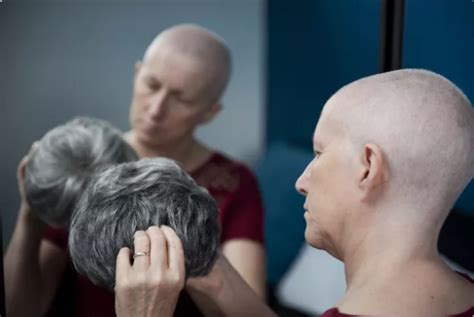Understanding the Impact of Cancer on Hair Loss
Cancer treatments, such as chemotherapy and radiation therapy, often result in hair loss. This can be a devastating side effect, leading to emotional distress and a decrease in self-confidence. According to the American Cancer Society, hair loss occurs in up to 90% of patients receiving chemotherapy.

Benefits of Wigs for Cancer Patients
Wigs can provide a sense of normalcy, privacy, and confidence for cancer patients experiencing hair loss. They can:
- Cover the scalp and minimize hair loss
- Enhance self-esteem and reduce emotional distress
- Provide an alternative to scarves or hats
- Offer a sense of control and choice
Types of Wigs for Cancer Patients
Numerous wig options are available to meet the unique needs of cancer patients. These include:
Human Hair Wigs: Made from real human hair, these wigs offer the most natural appearance and feel. They are more expensive but provide the highest level of comfort and customization.
Synthetic Hair Wigs: Constructed from synthetic fibers, these wigs are more affordable and easier to care for. They offer various styles and colors but may not feel as natural as human hair wigs.
Custom Wigs: Fitted to the patient’s head shape and hair type, these wigs provide a personalized fit and realistic appearance. They are typically made from human hair and offer a high level of comfort.
How to Choose the Right Wig
Selecting the right wig can be overwhelming. Here are some factors to consider:
- Shape and Size: Determine the shape and size of your scalp to ensure a comfortable fit.
- Hair Type and Texture: Match the wig’s hair type and texture to your natural hair to achieve a natural look.
- Color: Choose a wig color that complements your skin tone and personal preferences.
- Style: Select a wig style that suits your face shape and lifestyle.
- Personal Preferences: Consider your comfort level, budget, and care preferences when selecting a wig.
Common Mistakes to Avoid
- Ignoring Comfort: Always prioritize comfort over style. Ensure the wig fits properly and is comfortable to wear for extended periods.
- Choosing the Wrong Size: An ill-fitting wig can lead to discomfort and irritation.
- Neglecting Care: Regular wig care is essential for extending its lifespan. Follow the manufacturer’s instructions for cleaning and storage.
- Expecting Perfection: No wig will replicate your natural hair exactly. Embrace the uniqueness of the wig and focus on finding one that complements your style and boosts your confidence.
- Hesitating to Ask for Help: Don’t hesitate to reach out to a wig specialist or your healthcare team for guidance and support.
Alternatives to Wigs for Cancer Patients
In addition to wigs, there are other options for covering hair loss in cancer patients, such as:
- Head Scarves: Head scarves are a versatile and affordable way to cover the scalp. They come in various fabrics, patterns, and styles.
- Hats: Hats can provide both warmth and coverage for the scalp. Choose hats made from breathable materials to prevent irritation.
- Hair Toppers: Hair toppers are smaller than wigs and cover only the top of the head. They can be used to conceal thinning hair or add volume.
- Semi-Permanent Hair Extensions: Semi-permanent hair extensions can be attached to existing hair to create a thicker, fuller look. They are less noticeable than wigs and offer a more natural appearance.
Where to Find Wigs for Cancer Patients
Wigs for cancer patients can be purchased online, through wig salons, or from healthcare providers. When shopping online, read customer reviews and check the return policy to ensure satisfaction.
Resources for Cancer Patients Needing Wigs
- Look Good Feel Better: A non-profit organization that provides free wigs and makeup tips to cancer patients.
- American Cancer Society: Offers resources and support to cancer patients, including information on wigs.
- Cancer Care: Provides financial assistance to cancer patients in need of wigs and other supportive services.
Table 1: Types of Wigs for Cancer Patients
| Wig Type | Material | Appearance | Feel | Cost |
|---|---|---|---|---|
| Human Hair Wigs | Real human hair | Most natural | Comfortable | Expensive |
| Synthetic Hair Wigs | Synthetic fibers | Variety of styles | Less natural | Affordable |
| Custom Wigs | Matched to individual | Personalized fit | Comfortable | High |
Table 2: Factors to Consider When Choosing a Wig
| Factor | Description |
|---|---|
| Shape and Size | Ensure a comfortable fit |
| Hair Type and Texture | Match natural hair for a realistic look |
| Color | Complement skin tone and personal preferences |
| Style | Suit face shape and lifestyle |
| Personal Preferences | Consider comfort level, budget, and care preferences |
Table 3: Common Mistakes to Avoid When Choosing a Wig
| Mistake | Explanation |
|---|---|
| Ignoring Comfort | Prioritize comfort over style |
| Choosing the Wrong Size | Ensure a proper fit to avoid discomfort |
| Neglecting Care | Regular care extends the wig’s lifespan |
| Expecting Perfection | No wig will replicate natural hair exactly |
| Hesitating to Ask for Help | Seek guidance from wig specialists or healthcare teams |
Table 4: Alternatives to Wigs for Cancer Patients
| Alternative | Description |
|---|---|
| Head Scarves | Versatile and affordable covering |
| Hats | Provide warmth and coverage |
| Hair Toppers | Cover thinning hair or add volume |
| Semi-Permanent Hair Extensions | Less noticeable than wigs and offer a natural appearance |
